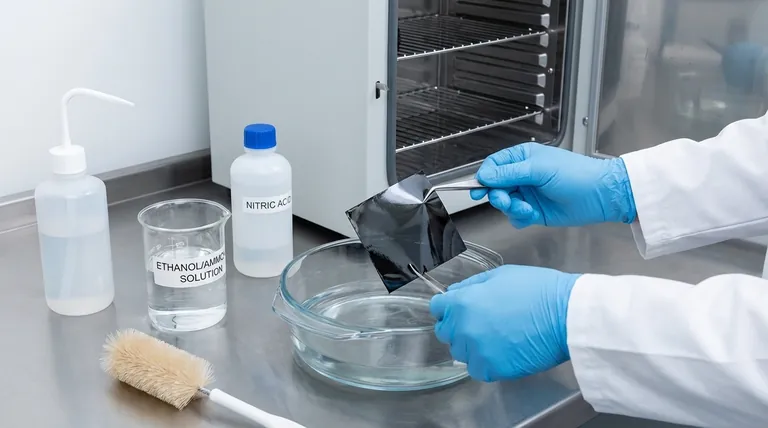To prevent contamination and damage to an RVC sheet, you must combine careful physical handling with a strict chemical cleaning protocol. The primary precautions are to avoid all direct finger contact with the surface and to protect the sheet from any impacts, collisions, or contact with sharp objects that could cause scratches or structural failure.
The performance and lifespan of a Reticulated Vitreous Carbon (RVC) sheet are entirely dependent on maintaining both its physical structure and its surface purity. This requires a disciplined, multi-step approach to handling, cleaning, and preparation before and after every use.

The Foundations of RVC Sheet Protection
Protecting an RVC sheet boils down to two fundamental principles: safeguarding its physical form and ensuring its chemical purity. Neglecting either one can compromise its performance in any application.
Preventing Physical Damage
An RVC sheet's porous, glass-like carbon structure is inherently brittle.
Gentle handling during transport, installation, and use is non-negotiable. Avoid severe collisions or impacts that could crack or shatter the material.
Furthermore, keep the sheet away from hard or sharp objects. Even minor contact can create surface scratches that degrade its structural integrity and performance.
Preventing Surface Contamination
The most common source of contamination is the oil and residue from your fingers.
Direct contact between fingers and the RVC surface must be avoided at all times. Always use appropriate gloves.
You should also prevent contact with any unintended organic materials or other substances that could adhere to the electrode surface and interfere with its function.
The Essential Cleaning and Preparation Protocol
Proper cleaning is not just a suggestion; it is a required procedure to ensure the RVC sheet is in its ideal state for any technical application. This protocol should be followed both before and after use.
Step 1: Initial Inspection
Before any treatment, carefully inspect the RVC sheet for pre-existing damage, such as cracks, chips, or significant defects. If any are found, the sheet should be replaced to ensure reliable results.
Step 2: Pre-Use Cleaning
To be effective, the sheet must be chemically clean. This process removes residual organic matter or metallic compounds from manufacturing or storage.
This is typically achieved by soaking and scrubbing the sheet with nitric acid or a 1:1 mixture of ammonia water and anhydrous ethanol or ethyl acetate.
Step 3: Immediate Post-Use Cleaning
After an experiment concludes, the RVC sheet must be cleaned immediately. This prevents reactants and impurities from drying or adsorbing onto the surface, which makes them much harder to remove later.
The cleaning method used after an experiment should be the same as the pre-use cleaning process.
Step 4: Thorough Drying
Once cleaned, all moisture must be removed. The sheet can be air-dried in a well-ventilated area or placed in a drying oven.
Ensuring the sheet is completely dry is critical to prevent water from interfering with future applications and to avoid potential microbial growth during storage.
Avoiding Chemical Degradation
While RVC is chemically robust, its performance can be compromised by exposure to inappropriate substances. Understanding its limitations is key to preserving its function over time.
Limit Exposure to Corrosive Agents
Avoid prolonged contact with highly corrosive substances. While not specified for RVC, a general principle for high-performance materials is that harsh chemical agents can slowly degrade the surface and introduce impurities.
Verify Size and Shape
Before integrating the sheet into your setup, confirm its size and shape are appropriate for your specific needs. Attempting to force-fit or modify the sheet can easily lead to breakage.
A Checklist for Reliable RVC Performance
Use this checklist to ensure your RVC sheet is always handled correctly, leading to more accurate and repeatable outcomes.
- Before any experiment: Always inspect for physical damage and then perform the complete chemical pre-cleaning and drying protocol.
- During all handling and installation: Use clean gloves, support the sheet properly, and move with deliberation to avoid any bumps, scratches, or impacts.
- Immediately after an experiment: Do not delay cleaning. Follow the same chemical protocol you used for preparation and ensure the sheet is fully dried before storage.
Adhering to these meticulous practices is the only way to guarantee the integrity and reliability of your RVC sheet.
Summary Table:
| Precaution Category | Key Action | Critical Detail |
|---|---|---|
| Physical Handling | Avoid impacts & scratches | Handle with gloves; support properly to prevent cracking. |
| Surface Contamination | No direct finger contact | Always use clean gloves to prevent oil transfer. |
| Chemical Cleaning | Pre- & post-use protocol | Soak/scrub with nitric acid or ammonia/ethanol mix. |
| Drying & Storage | Ensure complete dryness | Air-dry or use an oven to prevent moisture issues. |
Maximize the performance and lifespan of your lab equipment. Proper care of sensitive components like RVC sheets is crucial for accurate results. KINTEK specializes in high-quality lab equipment and consumables, providing the reliable tools and expert support your laboratory needs. Contact our experts today to discuss your specific requirements and ensure your experiments run flawlessly.
Visual Guide

Related Products
- Glassy Carbon Sheet RVC for Electrochemical Experiments
- Rotating Platinum Disk Electrode for Electrochemical Applications
- RRDE rotating disk (ring disk) electrode / compatible with PINE, Japanese ALS, Swiss Metrohm glassy carbon platinum
- Platinum Sheet Electrode for Laboratory and Industrial Applications
- Glassy Carbon Electrochemical Electrode
People Also Ask
- What is an RVC glassy carbon sheet? A High-Performance Material for Demanding Applications
- What are the fundamental characteristics of glassy carbon? Discover its Unique Synergy of Properties
- What are the typical physical specifications for glassy carbon sheets? Unlock Superior Performance for Your Lab
- What is the proper procedure for cleaning a glassy carbon sheet after use? A Definitive Guide to Ensure Reliable Results
- What is the ideal operating environment for a glassy carbon sheet? Ensure Optimal Performance and Longevity



















